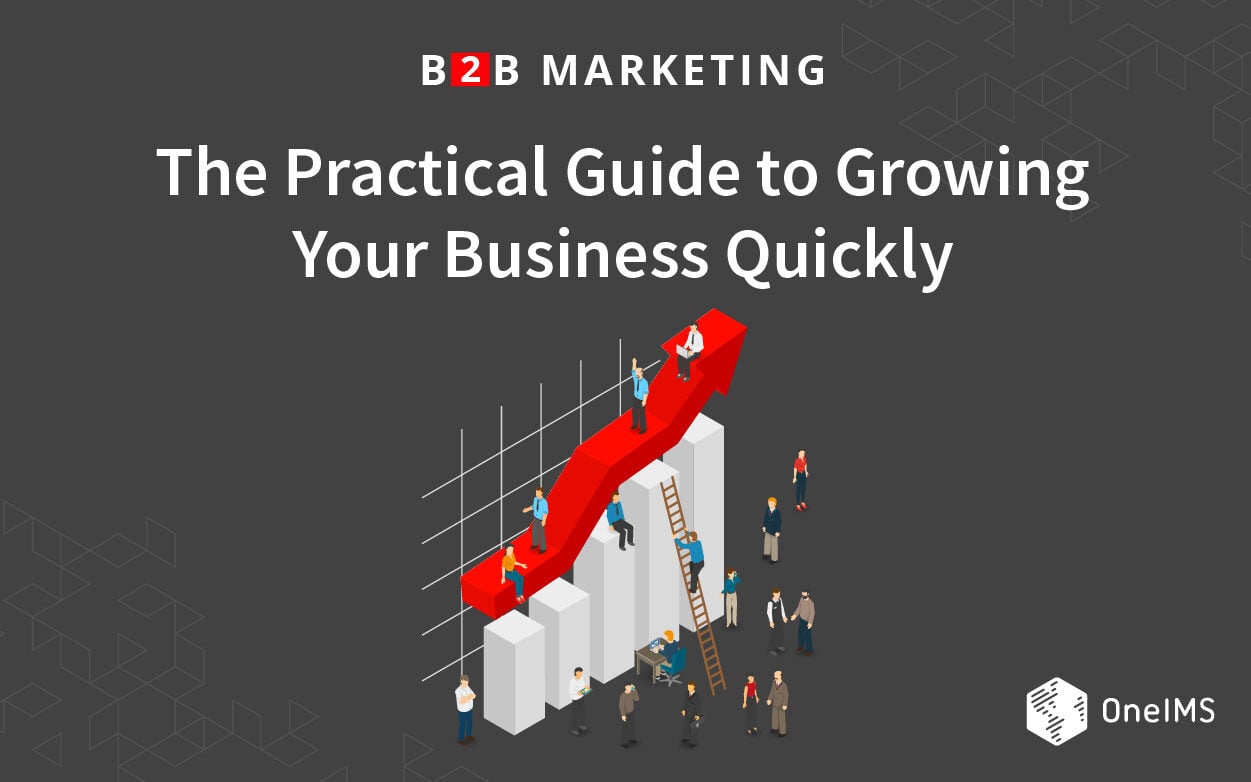Table Of Contents
Let’s show you how effective B2B marketing can help you to attract more clients and dramatically grow your revenue.
In this in-depth guide, you’ll learn how Xerox grew from 12,000 customers when it launched in 2009 to 135,000 in 3 years?
Isn’t that impressive?
Or how do you explain that Slack is currently valued at $7 billion with annual recurring revenue of $200 million?
The truth is that these companies take B2B marketing seriously. Their marketing team knows that best channels to reach qualified business and get them to sign up.
Make no mistakes about it. Companies are looking for you right now. Why? Because they want to buy your products and services.
The question is “how visible is your business online?”
When a business executive or decision maker, for example, conducts a search in Google for your business, will your website appear at the top or on Page 34?
You’ll discover how Dropbox increased subscriptions by 60%. It also generated $1.1 billion in revenue in 2017 and became the most established brand in cloud storage.
It boils down to leveraging digital marketing strategies. Of course, traditional direct sales still work but it’s quite expensive these days. In comparison, a broadcast TV ad costs $28 while a social media ad costs $2.50, radio is $10, direct mail is $57.
As you can see, digital advertising tops the chart when businesses want to efficiently reach their target audience, increase revenue, and save money at the same time.
What steps are you taking to let other companies know that your products, services, and brand exist? How do you communicate your message so that it resonates with other businesses that you’re reaching out to?
B2B marketing approach is quite unique because you’re not trying to reach individual consumers but businesses. That’s why you should start investing in B2B marketing channels.
Research by Deloitte shows that most B2B companies allocate 15% of its budget to marketing each year, and CMOs spending on paid media increased from 22% to 25, according to Gartner CMO Spend Survey 2017-2018.
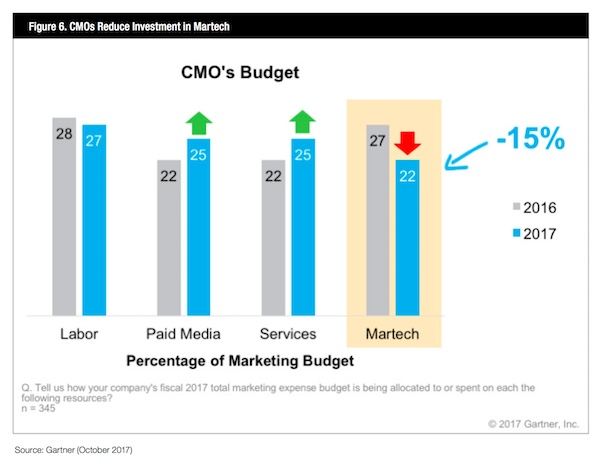
Since your goal is to increase brand awareness, generate business leads, and grow your sales, and develop a long-term relationship with other brands that will last for years — you need to embrace modern B2B marketing best practices.
Don’t just throw your money at the next shiny channel, think it through with your management team and make the right decision.
If you don’t know how to get started, don’t worry, we’ll show you exactly how to go about it. It’s quite simple if you follow this rich guide.
Of course, there may be an overlap between a B2B and B2C marketing strategy, but often times, you’ll need a different plan to execute your B2B campaigns.
What is B2B Marketing?
B2B marketing refers to the strategies and best practices that companies use to promote their products and services to other business.
You want to build a ‘marketing plan’ that your team can leverage to generate consistent leads, increase website traffic, and become a strong brand.

The goal is to let other businesses see the benefits of your product without being misled or deceived.
Although there are several ways to deploy a B2B marketing campaign, the ultimate objective to ‘give’ value first before asking for a commitment in return. We’ll go into much detail below…
Develop a B2B Marketing Strategy
Your B2B marketing strategy lays out the step by step plan for achieving your goal. It’s not enough to visualize how many leads your business would like to acquire in a year, there must be a plan to achieving it.
Follow these 4 steps to develop your b2b marketing strategy:
1). Effective Brand Messaging: Before you can broadcast your brand message to your target audience, you have to be sure about the value you bring to the marketplace — that’s just common sense.
Your Unique Value Proposition (UVP) must be clear and your team should understand it so that they can, in turn, communicate it better to the audience.
For example, FreshBooks has a recognizable brand message “All-In-One Small Business Invoicing and Accounting Solution.”
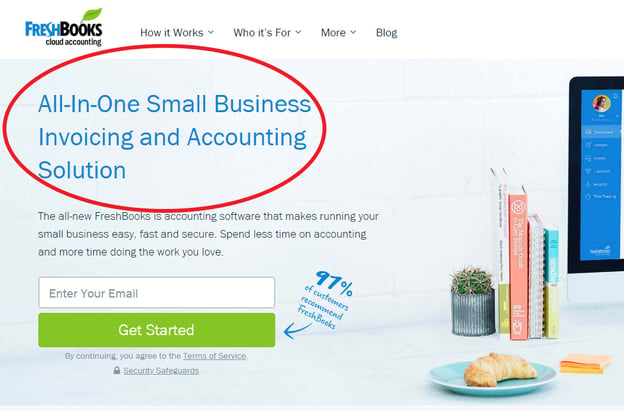
What’s your brand message? Can your ideal customer relate to it from a mile away?
Sadly, so many B2B firms are struggling with identifying and clarifying their key messages based on brand priorities and what their customers need. To get it right, highlight your strongest benefit as your unique value proposition.
If your business provides project management tools for tech. companies, for example, then your UVP would be similar to any of these:
-
Simple Project Management Solution For Your Business
-
Easily Manage Your Project With Your Team
-
Your Team, Our Software, A Reliable Team
Once you’ve identified what’s important to your brand, this may be the best time to develop strategies to reach your audience via various online and offline channels.
2). Competitive Analysis: This is an effective step that enables you to spy on your competitors and replicate their strategies in your campaigns.
Through competitive analysis, you get to understand which marketing tactics and methods are most effective for connecting with customers in your industry.
Competitive analysis is important because it lets you Discover, Segment, Track, and Measure performance across your marketing channels — to determine whether your strategies are producing results like your competitors’ are currently doing.

One thing you can do is to find out why your competitors are always ranking higher than your business’ website in the Google organic listings.
In this case, a quick analysis with the SEMrush tool which reveals the keywords that your competitors are targeting which you’re not even aware of. You’d also see their best backlinks which are driving their search rankings.
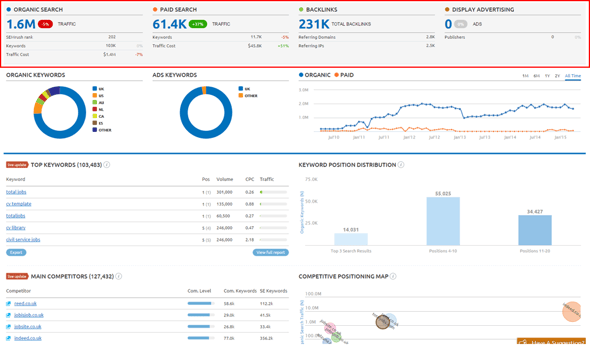
When you’re armed with these insights (keywords and links), then you can develop a better plan to target the same keywords (and even did deeper to find keywords that your competitors are not using) as well as get powerful links from the same websites that helped their rankings.
Spying on your competitors is totally legit as long as you don’t use the data to dent their brand.
Using it to improve your online visibility is important if you want to generate better leads and thrive in this competitive B2B marketing environment.
3). Digital Strategy: As a B2B company, you have a plethora of digital channels and tactics (e.g. company website, social media, PPC campaigns, email marketing).
However, if you want to see significant results with your B2B marketing strategy, you need to stop using siloed approach and start using a strategic approach. That means integrating it into the overall marketing strategy — only 34% of marketers are currently doing it.
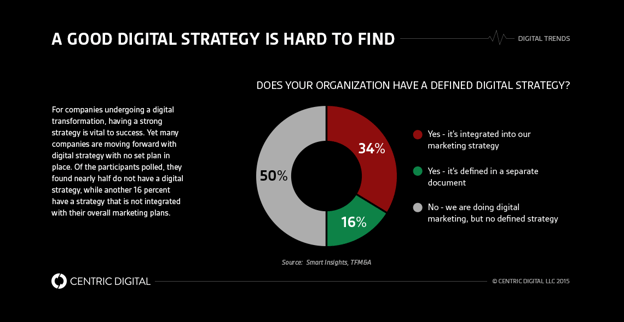
The former involves using one channel independently.
The problem with it is that your ideal customers want a seamless experience across every channel. In other words, when they see your brand on Facebook, it should feel the same as your message on Twitter, Blog, Email, you name it.
A strategic approach is more powerful. It involves designing a coordinated digital strategy that connects every digital all your marketing tactics as a single hub for achieving your goal.
4). Measurement & Analysis: When there’s a constant improvement in your B2B marketing strategy, you can almost guarantee a 100% growth. Why?
Because you’re measuring everything and highlighting critical gaps in your marketing campaign. This enables you to plan accordingly and to accurately align your strategy with industry benchmarks and what the market demands in real-time.
B2B Marketing Vs B2C Marketing: The Core Differences
Essentially, marketing is important for both B2B and B2C companies. However, how both organizations go about it differs. Even though a hyper-targeted campaign is needed in both cases, B2B marketers often struggle with reaching other business.
After all, there are more individual customers than there are companies. So the odds of losing are always high for B2B companies that want to generate more leads and customers.
In sharing the major differences between B2B marketing and B2C marketing, here’s a case scenario:
i). Reach: If you operate a B2B company, you can reach any individual prospect who would be interested in your product, even if that person doesn’t want to buy now or even want to. This person could refer their friends, family members, colleagues at work, or even strangers to your business.
And they mostly do it willingly because they perceive that the product is valuable. So a woman can refer her friend to your online jewelry store even though she’s not ready to buy now.
In other words, B2C marketers are reaching the decision makers almost instantly. If I see a shoe that I like and I have the money, I don’t have to wait for my mom to approve of it. I just fling my credit card and get it.

ii). The Decision-Making Process: B2B marketing involves appealing to a specific group of people, another business, or an organization. If these people aren’t the decision makers, how long do you take the transaction will take to complete?
For example, If a marketing expert at Adobe sees a software that would help the company in some way, he can’t buy it because he doesn’t make decisions for the company. He has to follow the hierarchy and hopefully, the organization will see reasons with him.
Again, if the customer service department needs 5 new chairs for their new attendants, only the top-level employee would choose to approve the purchase today, tomorrow, next week, or never. That’s B2B decision-making process for you!
That’s why the decision makers should be your target when you’re a B2B company. You want to make them see reasons with you. If you run a Facebook ad, then it should target decision makers in the organization, not individuals.
With Facebook advertising, you can target by job title and your ad will only be seen by those group of people or top executives who meet your job title (e.g., managers, content editors, CMO, web developer).
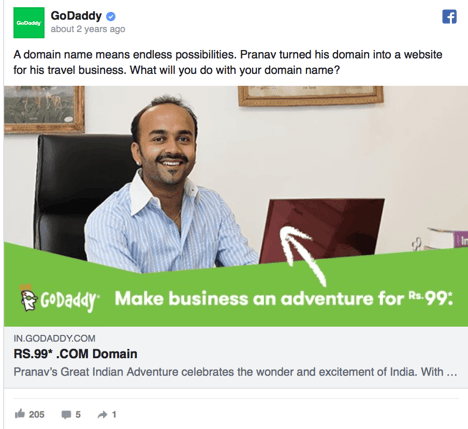
B2B Marketing Challenges
B2B Marketing is not without challenges. In fact, due to the availability of marketing channels and a variety of content formats, the major challenge is how to blend-in everything so that it works for the business.
In this section, we’ll consider a few of the challenges that may come your way as you’re deploying your B2B marketing strategy.
1). Measuring Revenue/Outcomes
How do you measure and prove ROI of your business’ marketing efforts when ‘content’ may not bring in the desired results yet? The truth is that using digital marketing techniques to grow a B2B company works but it takes time.
HubSpot once conducted a study and found that 4 out of 10 marketers are concerned about demonstrating ROI of their marketing activities. 45% of marketers don’t even measure their ROI. This is a big challenge for a lot of businesses right now.
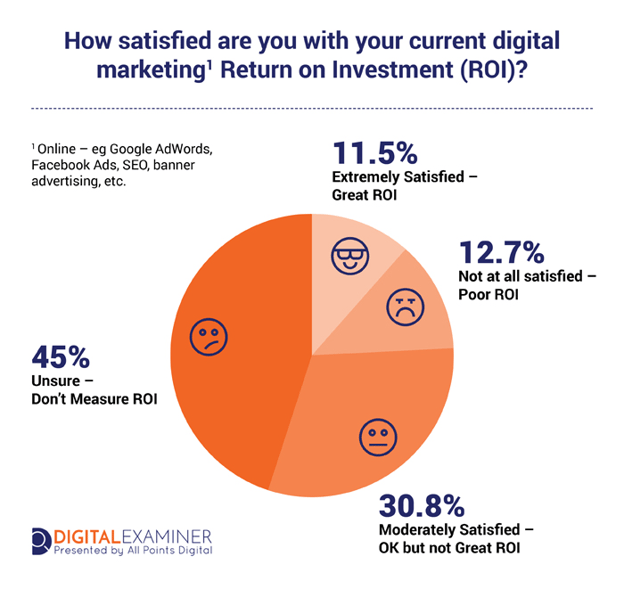
Whether you’re running Facebook or Google ads as your primary source of growing leads and sales, there’s no way you can boost ROI overnight.
It requires a lot of precise planning on your part to make sure your content ROI is easy to measure from the very beginning.
The best way to overcome this challenge is by stating your Key Performance Metrics. That is, be sure of what you’re going to measure as your success for a given campaign.
-
Is it generating leads or getting sales?
-
How many new sign-ups do you need in 30 days?
-
Do you want to double your website traffic in 6 months?
-
What about publishing 10 more articles in a month?
Any or all of these Key measurable goals can be your benchmark for measuring success, and also how it drives your ROI.
Once you’re clear about your goal, then you can decide on key performance metrics to measure the success of your marketing activities. Some of the common metrics are:
-
Click-through Rate
-
Total website visits
-
Average Time on site
-
Customer Lifetime Value (CLV)
-
Lead acquisition cost
-
Bounce rate
-
Pageviews
-
The number of generated backlinks
-
New keywords rankings
You can’t possibly monitor your key performance metrics manually. There are so many tools out there — Google Analytics is handy and detailed. It’s also free.
2). Finding the Time
Time is valuable and sometimes, it can be more valuable than money. As a result, online marketers are constantly asking for more time to do more content creation, social media engagement, and even influencer marketing.
A study by ClearVoice shows that time is the biggest challenge faced by B2B marketers.

Businesses don’t know how to save time to do what matters in their job. One reason is poor time management. The other reason is that inbound marketers juggle multiple roles in their workplace.
For example, I know a top-level manager who is also the social media manager for the company. He’s also responsible for hiring and firing new staff (that’s supposed to be the job of human resource manager).
How do you find more time?
Utilize automation!
Marketers who juggle multiple roles can use a variety of automation tools to get the job done.
For example, my friend who’s a top-level manager and the social media manager of his company now uses Buffer, a social media management tool to schedule posts in advance for Facebook, Twitter, and Instagram.
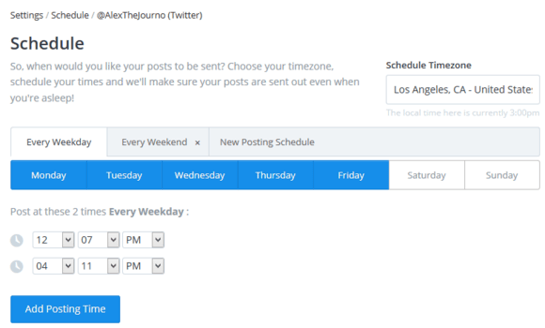
He simply adds the posts, set the date and time, and click ‘schedule’. That’s it. The posts will be seen by the followers even when the brand is offline.
3). Staying Updated with Mobile Trends
These days, it’s all about mobile technology, mobile phones, mobile ads, mobile-friendliness, mobile is a part of our lives now.
Consequently, a lot will change. Businesses need to keep up with these changes and align them with their decision-making processes.
Adobe conducted a survey on issues affecting the mobile industry and found that 68% of marketers believe it’s important in their mobile content marketing.
Also, 71% of marketers believe mobile marketing is integral to their business’ growth. Hence, they need to improve the knowledge, skills, and creativity to get the best results.
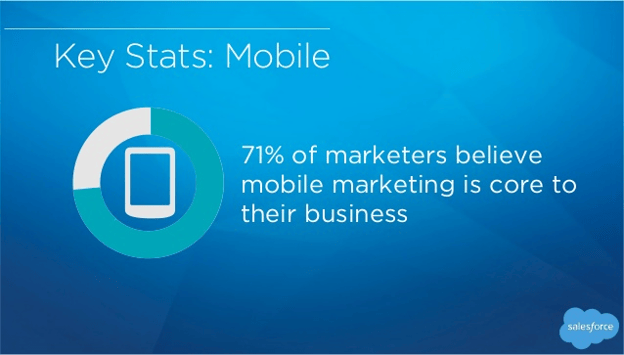
One of the best ways to overcome the challenge of keeping up with mobile trends is to optimize your mobile site. Use responsive design so that your existing website will fit any screen or device (desktop, tablet, or smartphone) the customer is using.
Above all, make sure you frequent mobile marketing websites and study State of Mobile Marketing for the year. This will keep you updated on the latest mobile trends.
B2B Marketing Strategies
At OneIMS, we help businesses deploy effective B2B marketing strategies that will enable them to outperform their competitors in the search results, become the go-to brand in their industry, and drive increased revenue.
Having known how to develop a winning B2B marketing strategy, the challenges you’d face and possible fixes, it’s time to get your hands on the best strategies for generating traffic, leads, and revenue.
Bear in mind that these marketing strategies can work for B2C companies, the only difference is how you approach it. Why?
Because the content that a B2B company produces to attract other businesses or a group of persons is quite different when compared to the content that a B2C company produces to sell directly to individual buyers who make decisions.
B2B content is created to help speed up the decision-making process of a top-level executive, CMO, or founder. When they see the need for your product/service, they will quickly call a meeting to discuss how to get it. All the key departments will be represented.
With that in mind, here are the best B2B marketing strategies and tactics you can implement today:
1. Target Your Demographics With Custom Content
We’ll discuss ‘custom content’ and how it fits perfectly into the mix. But first, it’s important to conduct market research to know who your ideal businesses are. Are you looking to acquire small business owners or Fortune 500 companies?
Either way, you must have a precise picture of who you want to attract. Otherwise, you’d be wasting your digital advertising spend. And I’m sure you wouldn’t want that to happen?
Your demographics are usually characterized by age, gender, and income.

Source: Mary Pomer
Your targets can be refined. Don’t try to market to every business in America, that’s insane. Don’t even desire to reach every business owner in Chicago, that’s ridiculous. How can you possibly attempt to reach everyone?
Focus on your core audience.
Ask yourself these questions:
-
Who is my ideal audience and can I easily map out their profile (i.e., buyer persona)
-
What do they like or dislike?
-
What’s their buying habits and income status?
-
What pain points do they battle with that my products/services can solve?
-
What channel or platform do they visit frequently?
Google Analytics is a good place to start. Once you install the tracking pixel on your B2B website, it’s easy to track your visitors, their interests, demographics, traffic sources, bounce rates, etc.
When you notice that your website isn’t reaching your main demographics (e.g., female nurses in the United States), then you can create a better strategy to promote your content and business to suit your demographics.
Find authoritative websites in your industry with huge traffic and write guest posts for their audience.
If you do this consistently, you’ll start reaching customers in your demographics, while steering away from irrelevant demographics.
2. Create and Promote an Engaging Website
It’s time to get your business website right.
You may have a big budget for SEO, PPC, or even traditional media, but none of these would produce the expected results if your website is off.
Your company’s website should be designed to appeal to your audience, persuade businesses to trust. A poorly designed website is a dent on your corporate ethics and culture.
A great website will cost your organization money, but it’ll be well worth it when you start to attract business’ leads and new business relationships.
Cisco is one of the B2B companies that take website design seriously. Their homepage is unique, clean, with a captivating Unique Value Proposition.
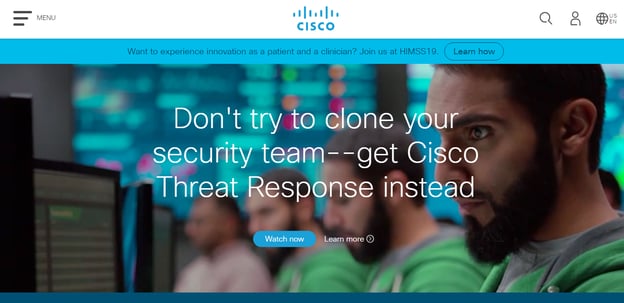
Most companies are looking for the ‘next’ big marketing technique or channel. When Pinterest came to the scene a few years ago, businesses were responsible for promoting it.
They quickly forget the asset they have — their website.
According to Denis Pinsky:
To get great digital results, your website must be engaging; it must offer dynamic user experience. Of course, beautiful graphics are essential to the design process. However, to drive digital success, your site must offer more than compelling graphics. Make sure your developer is concerned about creating a functional infrastructure of both site and SEO functionality. This must be fully developed and tested before going live. Essentially, that’s how your audience can experience the power of a great website.”
Your company’s website isn’t just another branding buzzword that just creates a presence online. No, it’s a powerful tool. It represents your business to your target audience. It sends a signal of your expertise, quality, and value.
Your B2B website creates that first impression which is crucial to winning other businesses. In fact, 80% of people visit websites while checking out service providers. 90% of online consumers will first visit a brand’s store before shopping — so your website is the billboard that people see.
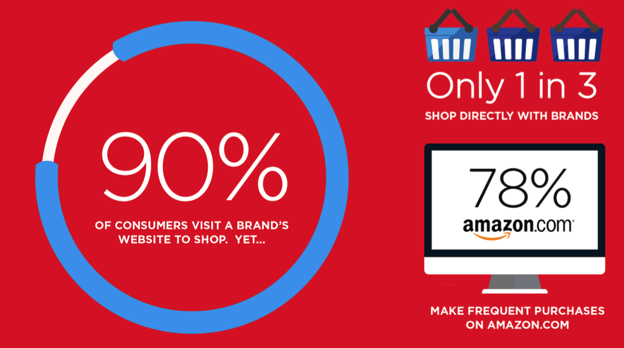
Apart from the design that you’ve adopted on your website, make sure your content is engaging, informative, and provides a good user experience. Your website should drive targeted leads to your business.
If it’s not doing it, then you need to redesign it, or at least, improve its conversation rate.
Keep these thoughts in mind when designing your company’s website for the purpose of reaching other businesses or group of persons:
-
Make sure your homepage is clean and has a strong message that resonates with your audience.
-
Create landing pages for the purpose of promoting your products and services.
-
Optimize your pages (including Services, Products, FAQs, Team, etc) with your primary keywords.
-
Use mobile-responsive themes and templates for your website. This is important for mobile users.
-
Include catchy call-to-action buttons to encourage website visitors to download your white paper, schedule a meeting, get a free consultation, or sign up to a free trial of your software.
-
Include honest testimonials and social proof on your homepage (also, include it on a dedicated page). Video testimonials are always better since they’re easily trusted by new businesses.
Create Custom Content
Above all, share custom content: Custom content is that type of content that stems from your brand and deep knowledge of what your audience want. This content is tailored to your specific audience. Here’s a good example:

A case scenario:
Custom content is truly important if you want to nurture leads into paying customers.
Although custom content is reserved for premium users or sent to members who enrolled in a particular online course, you can use it to build stronger connections with your audience and bring satisfaction to them.
Custom Content Council conducted a study and found that 61% of consumers feel better about a company that shares custom content. They’re also more willing to buy products from that company. More so, 90% of consumers find it helpful.

3. Effective Website SEO
Search Engine Optimization (SEO) is important for your company. Since 93% of online experiences begin with a search, you can’t ignore how many leads and customers your business can generate from Google.
SEO may seem complex and time-consuming, but it boils down to getting two things right:
a). On-Page SEO: This takes care of your website and everything that included on it, plus what happens to your pages, content, links, keywords, indexability, etc.
You want to make it easy for search engine crawlers to find your new pages (especially when you publish a new content) and serve it to business owners and top executives that are searching in Google.
b). Off-Page SEO: This primarily involves getting the word out about your business. Everything that connects your company’s website to the external resources, platforms, and social media sites.
Getting other websites to reference/link to your pages is important. When Google sees other websites linking to you naturally, it tells Google that users are happy about your website. In turn, Google will push (i.e., rank) your site to the top of its organic listings.
In Off-Page SEO, you’ll gain better and many inbound links if you focus on building a stronger brand image. For example, I just linked to FreshBooks on this article, not because the founder or CEO asked me to do so, it’s because they’re popular and deserve the link.
That’s one of the benefits of building your online reputation and authority. Website owners, businesses, and social media followers will gladly reference your website.
John Lee Dumas and Pat Flynn are two guys who have build a strong authority in the online entrepreneurship environment. As a result, they generate a lot of leads and their revenue is in the 7 figures annually.
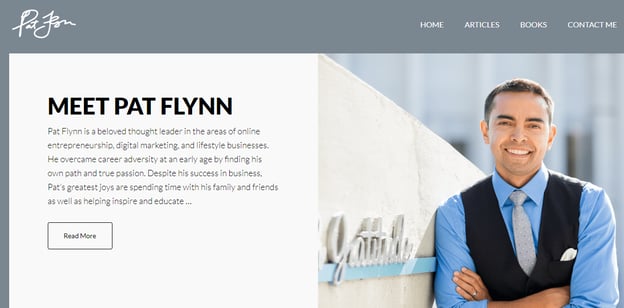
However, building up your authority takes time.
For us, it took 2 years to achieve that ‘authoritative’ status. For the businesses that we’ve helped grow their influences online, it took 6 to 12 months to create massive awareness for these brands.
While you’re waiting for your company’s website to get noticed and gain traction online, you can drive it. How?
Find already-established websites in your industry and write articles for them. Then link back to your website homepage, services page, or preferably a page that adds additional value to the guest post.
GrooveHQ, a Help Desk Software Provider used guest blogging to attract 1 million people.

You can also do email outreach. Cold email outreach may look scary but it produces great results.
For example, Ambition, a software provider that helps businesses boost employee productivity used this strategy. The software is being used by Lyft, Carbonite, and more.
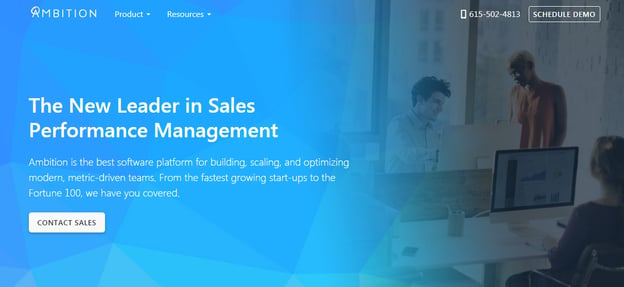
The team sent out cold emails to 578 businesses, ran a six-week campaign targeting 291 VPs of sales and 287 VPs of operations. As a result, they generated 73 new leads.
This graph shows the overall nature of the cold email campaign and their results:

To deploy a successful email outreach, you’ll find email addresses of businesses. Send them a simple email letting them know you just published a valuable article, white paper, or industry study on your website.
Better yet, invite them to try your product at no cost.
If they like it, a percentage of them will link back to it. Assuming your send email to 1,000 businesses (that’s a lot of work), and 40 of them replies and adds your website to their resource page, that’s 40 high-quality links.
Contact OneIMS if you need help with email outreach.
These 40 links alone can get your website to the number #1 of Google results. It depends on the competition, but it should get you closer to the top. If your page is targeting a long-tail keyword, then you can quickly rank at number #1 within 60 days.
4. Leverage Pay Per Click Advertising (PPC)
Pay Per Click advertising offers a quick way to attract new clients at the early stage of your business. It’s also a great way to get your best content in front of businesses that would love to work with you or buy your product.
PPC costs money but if you do it the right way, you’d be saving more money on the long-run instead. With PPC, you’re paying for ad clicks, which means you’re charged some money for every click your ad generates.
St. Regis Homes used PPC advertising to increase overall website visit (467%), boosted lead generation by 1813%, and recorded a 396% increase in site conversion.
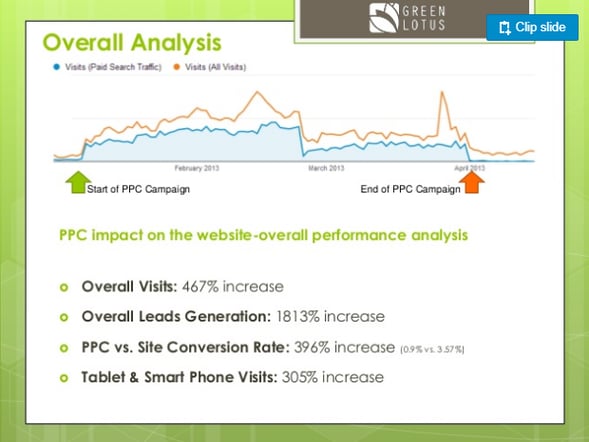
This can be manipulated because potential clients may just click on your ads even when they don’t want to buy your product or download your white paper.
That’s why taking advantage of other advertising options which allow you to pay for other actions like impressions, on-site engagements, product downloads, video views, and so on.
With any of these options, you’re paying for reach or for the exact goal you had in mind before creating your ad.
5. Blogging
Many companies are spending a lot of money on traditional media (TV, Radio, Magazine, etc), forgetting that a simple blog that provides value can help them to generate better (if not more) leads.
Blogging is a way to provide free information to your target audience. These people are already sick and tired of distracting ads on media sites and social media. They want some good experience.
More importantly, 80% of business owners who make decisions (these are B2B ideal clients) prefer to read useful articles than see advertisements.

As a business, you should spend money on website design. But don’t stop there.
Why? A simple makeover on your website will not change anything. It’d only generate some appreciation from your existing users. A beautiful website doesn’t generate business leads. It doesn’t grow revenue.
Tell me: When was the last time you visited a website solely because it’s colorful?
See, you can’t even recall…
I guess you’re more interested in the content. Even if the design doesn’t win the Box Office, people will love it for the content.
A blog is an engine that will transform your B2B marketing into a successful lead generation pipeline. It’s the best form of inbound marketing for your business.
Blogging alone can help your company to build excitement in people instead of pissing them off.
“We wanted to stop pissing people off and shift marketing in a way that people loved,” says Tom Wentworth, CMO
Tom Wentworth the CMO of Ektron, a B2B company with more than 3,800 customers. Ektron provides innovative web content management software for corporate websites and social communities.
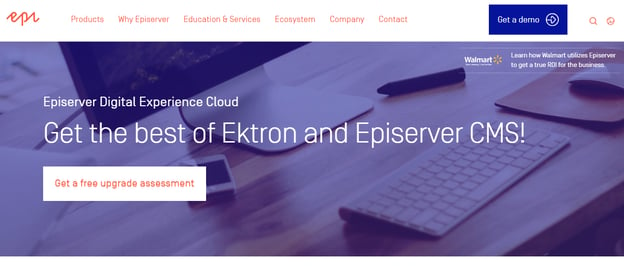
By leveraging blogging and different forms of inbound marketing techniques, the company generated 40% qualified leads and 73% of qualified opportunities to reach even more people.
You’ve seen how powerful blogging can be. So why does blogging work?
Isn’t it obvious? Okay, through blogging, you create helpful content with actionable tips that users can implement right away.
This may be different from a white paper that simply gives an overview of the product or a subject. A blog post (or a blog article) is written from the standpoint of inspiring the reader.
When people read your blog, they can share it on social media, write useful comments, link to the post, or download it to read later. More importantly, the more helpful blog posts you publish, the more businesses will perceive you as an expert.
A few things to keep in mind when blogging for lead generation:
i). Create educational content: This type of content will teach the reader something they have been struggling with. Perhaps, it’ll help them approach it better.
HelpScout, a company that provides Help Desk solutions to businesses has achieved tremendous growth through their educational articles. Take a look at their blog:
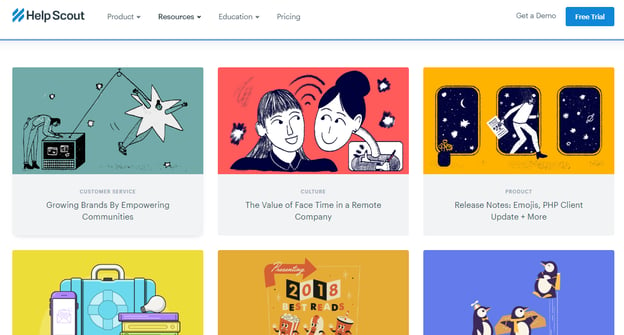
ii). Format your post properly: This is simple. Make sure you’re using short sentences to convey your thoughts. Use subheadings and bullets to highlight important points, add images (not stock photos but screenshots, graphs, illustrations).
Here’s a good example of a post that’s well-formatted. It has a heading, an image, quotes, short sentences, and white space:
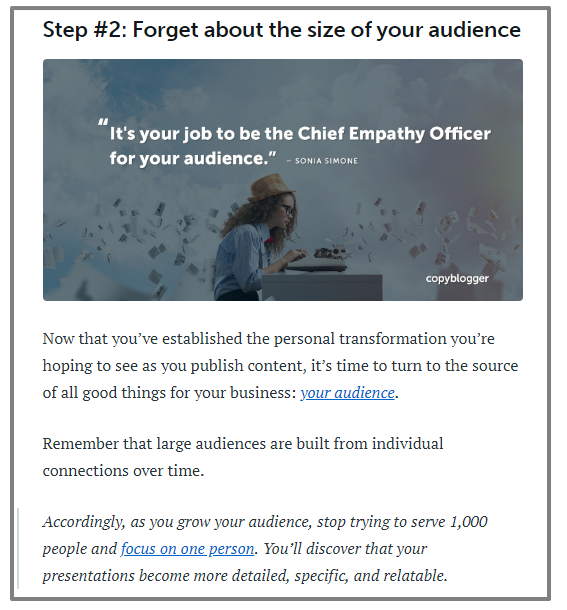
iii). Optimize for readers and search engines: Target a keyword in your post, especially in the title. But provide actionable tips that users can use right away. Remember that if the user is happy, search engine crawlers will reward your website with higher rankings.
iv). Use proper calls to action: At strategic locations on your blog post, include clear and relevant call-to-action button or link. This should lead readers into your email list or to your product page. Here’s an example from OntraPort.
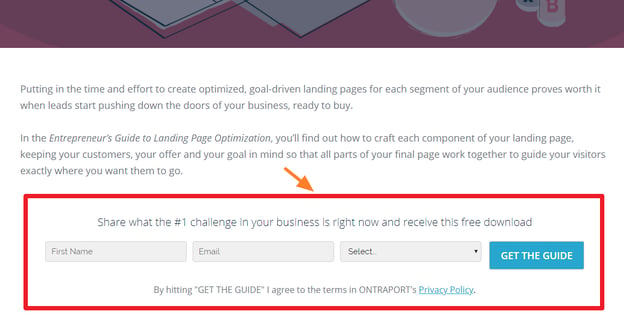
v). Promote your content: The only way to NOT get results from blogging is when you publish content and you don’t promote it. To a large degree, content promotion is more important than content creation.
Letting your content sit on your blog and generate readership over time is good but it’s not a smart idea. Don’t be one of those businesses that publish content and pray.
Take steps to promote your content and let other businesses know about it.
Spend a portion of your marketing budget on paid promotions especially via search engine marketing (i.e., Google Ads & SEO). According to 54% of B2B marketers, search engine marketing is the most effective method for promoting their content.
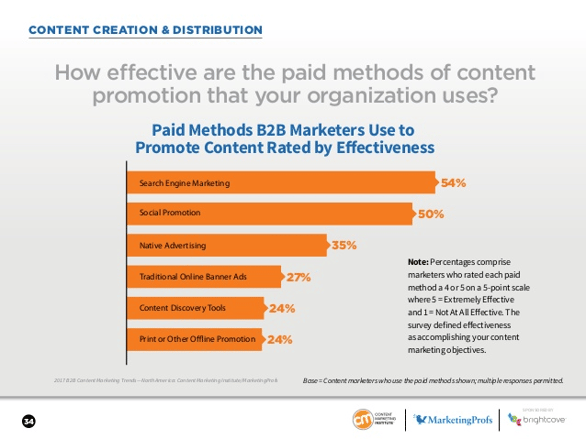
When you combine educational content and promotion, you’ll generate more traffic and acquire more leads for your business.
So, share your blog posts on Facebook, Twitter, and pin the images as well on Pinterest.
Send the post to your email subscribers, repurpose it into a variety of formats (e.g., infographics, videos, slide presentations, podcasts) and distribute in their respective platforms.
If you invest in content promotion, you’re sure to generate more B2B leads that will become paying customers.
Final thoughts
B2B marketing demands a different approach. If you do what B2C marketers are doing, you’ll get poor results because the two models are not ‘exactly’ the same.
As a rule of thumb, find out the decision makers in the businesses you’re reaching out to. Spend some time interacting with top business executives and CMOs, understand their standpoint, their pain points, and what excites them.
You’ll use these insights to create better content for them, run more targeted ads that will appeal to them, and personalize their experiences at the different stages of their journey.
Leverage your brand story to win more clients, since they’re human beings and will connect to a good story.
All in all, focus on customer satisfaction. Because in the end, that’s what matters — it’ll increase the chances of getting loyal clients who will stick to your brand and become brand ambassadors.

